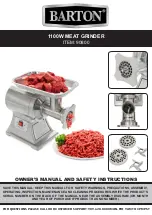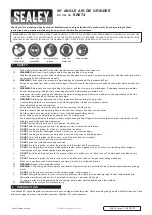
- 19 -
ABRASIVE DISCS
Purchase high quality abrasive discs which have the maximum
external diameter indicated in the technical details of the grinder,
a suitable hole which fits the requirements of the flanges, and
which are suitable for the maximum speed of the grinder and
the materials to be processed. Contact your retailer who will be
able to give you the best advice. Our company produces a wide
range of accessories suitable for various uses.
Through use, discs wear thin, loose their calibration and expire
after a certain date: always make a visual check before using
and replace if necessary.
For the assembly and replacement, go to the “INSTALLATION -
Abrasive disc assembly” chapter.
Handle and store the discs with care, do not subject them to
impact, bending, compression, moisture, high or low tempera-
tures, and direct sunlight.
ELECTRONIC SPEED REGULATION (where fitted)
You need to assess the type of work, type, diameter and material
of the part; perform tests at several speeds on a scrap part
before performing on real parts.
In general set the speed according to the following chart, depen-
ding on the type of work and accessory used. Also observe any
information provided with the parts; never exceed the maximum
rotation speed indicated.
For the backing pad (pos. 19) use only low speeds under
6,000 min-1.
Works
Accessories
Material of the
part
High speeds
≥6000 min-1
<
15000 min-1
Cut
Grind
Abrasive discs
for cutting and
grinding
Metals
Hardwood
Low speeds
>
3000 min-1
<
6000 min-1
Brush
Polish
Clean
Rotating
brushes
Backing pad
with abrasive
paper disc or
fabric disc
Coated surfa-
ces
Plastic
Softwood
Heat-sensitive
materials
USE
IMPORTANT! It is forbidden to use the angle grinder with
only one hand.
Wear the personal protective equipment listed in the “Warnings”
chapter.
The piece you are working on must always be firmly secured
to the workbench, using a vice or other device, especially when
working on small, lightweight pieces.
Hold the device with both hands. The power cord must be kept
far from the rotating parts and from your body.
After assembling the part and choosing the speed (if present),
start the device keeping it far from your body. When the tool
is turned on, handle with caution, as any carelessness may
cause even serious injury; therefore keep unauthorised persons,
children and pets away from the work area.
The correct position of the operator is with arms stretched
forward, the angle grinder straight with the disc facing forward
and the disc protection facing the operator.
When in contact with the part, the angle grinder will tend to move
laterally with a force which is proportional to the pressure you
will exert on the work surface; contrast this movement in order
to keep the angle grinder in position. Furthermore, unexpected
kickbacks are always possible. See the “Warnings” chapter to
prevent and contrast this.
Depending on the type of process, perform on the part carefully
and proceed gradually without making forceful movements.
Excessive pressure on the part could cause the accessory to
break and tiny fragments may unexpectedly be launched in your
direction; in addition, the power tool will be put under even more
strain and it will not have a long life span or may stop functioning.
Avoid getting your face too close to the work area and always
keep a certain safety distance.
When using the angle grinder on metal parts, sparks may fly;
this could damage nearby objects or cause a fire/explosion if
put in contact with flammable elements.
When performing trimming operations, keep the angle grinder
inclined at 15°-20° against the surface on the workpiece.
Brushing on painted or oxidised surfaces, will produce a large
quantity of dust, even when working on metals and certain types
of wood. The dust is harmful to your health.
When sanding or polishing, do not apply excessive pressure,
simply use the weight of the angle grinder. When working on
painted surfaces, always proceed with caution in order not to
scratch the surface; it is advisable to perform a test on a part
which is not highly visible.
Once you have finished, switch off the tool, place it on the table
and unplug. Do not switch off the device while it is rotating
against the part; wait for it to stop rotating before placing it
on the table.
MAINTENANCE
IMPORTANT! Before any checks or adjustment unplug the
tool from the electric power supply.
IMPORTANT! Do not tamper or attempt to repair the power
tool.
IMPORTANT! Any internal service or replacement of the
motor’s graphite brushes must be carried out exclusively
by an authorised service centre.
The working life and costs also depend on constant and meti-
culous maintenance.
Take good care of your power tool and clean it regularly. In this
way its efficiency will be ensured and its lifespan extended.
- Remove dust and machining residuals with a cloth or a brush
with soft bristles.
- Do not wet or spray water over the power tool - risk of internal
infiltrations.
- Do not use any inflammables, detergents or solvents.
- The plastic parts can easily be damaged by chemical agents.
- Do not use compressed air for cleaning: Risk of material
ejection!
- Be careful when cleaning the switch, motor fan slots and
handgrips.


































